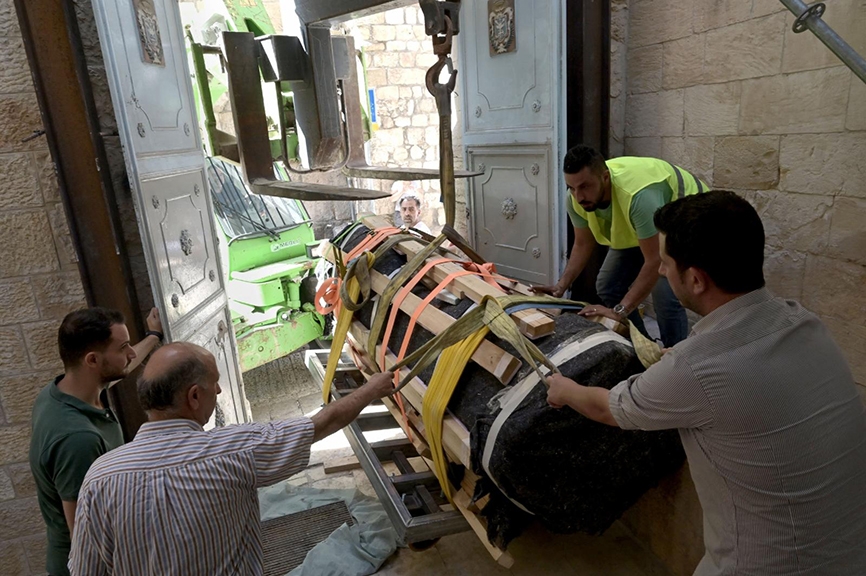
JERUSALEM. Moving a 4.7-ton piece of an ancient marble column is never easy.
When the piece is from a column that was once part of the Church of the Holy Sepulcher, making sure it is transported safely is all the more important.
Restoration experts were moving the piece June 10 – to be followed by several others – from the hermitage garden of the Church of Gethsemane to the Franciscan Terra Sancta Museum in Jerusalem’s Old City.
Sara Cibin, project manager of the Pro-Terra Sancta nongovernmental organization, and a team of Italian restoration experts from Restorers Without Borders felt relieved when the piece reached the archaeology wing of the museum.
The piece is one of several segments from two pillars in addition to two ornate decorative column tops – known as Corinthian capitals – that have been kept at the garden on the Mount of Olives since 1969 following renovations at the church. Moving them has been a year in planning.
It will take a week to transport the remaining pieces as restorers use a special forklift strong enough to carry the massive segments yet small enough to maneuver inside the narrow streets of the Old City.
The museum is located on the grounds of the Church of the Flagellation on the eastern side of the Via Dolorosa near the Lions’ Gate, also known as St. Stephen’s Gate.
“It is a roller coaster of emotions,” Cibin told Catholic News Service. “I feel very happy because it is a great achievement after so many years to give these pieces a new life and to give people the opportunity to experience these pieces again and the story they can tell.”
Cibin said she has felt a huge weight of the responsibility in moving such a significant piece of history.
“It is very exciting but it also very stressful,” she said.
The architectural elements were discovered in 1969 during major restoration work of the Anatasis, where the aedicule, a small wood building containing Jesus’ tomb, is located. They were found inside a wall in the northern side of the Church of the Holy Sepulcher in an area administered by Franciscan Custody of the Holy Land.
The wall was built during the British mandate period in Palestine from 1917 to 1948 to replace the colonnade which had become fragile over time.
Withstanding the natural elements over the years has added to the fragility of the column pieces, which also were damaged in the past by a fire and an earthquake. Moving the architectural elements required careful planning, said restoration expert Pietro Coronas, who leads the team of Italian conservators.
“Our first challenge is not to break the columns. We don’t want to lose any piece,” he said. The pinkish-veined marble, he added, is most likely from a local quarry.
The exact age of the columns is unknown. Some samples were taken for dating analysis. The experts believe they originally came from a Roman temple built over the place of Jesus’ burial during the reign of Hadrian (117-138 CE) – but may actually have been reused from King Herod’s time.
The pillars were likely again reused during the construction of the Church of the Holy Sepulcher in the 11th century during the Byzantine period, Coronas said.
Preparing the pieces for transportation involved releasing them from the cement bases used to hold them in place. The pieces were cleaned using a special organic mixture, which includes oregano and was developed for use in the Vatican museums.
Restorers also conducted a 3D-scan, using thermography to identify cracks in the marble, some of which are not visible to the unaided eye. Thermography detects cracks by measuring the temperature variations on the surface of the stone, which will be colder in places where minute fissures have developed. Coronas said workers did not conceal all cracks discovered because they constitute part of the history of the pieces.
“In the museum it will be nice to tell their story and show also the damage they have suffered,” he said.
In addition to cracks, the team discovered ancient graffiti on the columns including initials and crosses carved into the marble. Remnants of ancient paint were still visible on a section of a column despite decades of exposure to the natural elements, he said.
Special structures were set up inside the museum to move the pieces from the entrance to their permanent exhibition space.
“Inside the museum we can’t use machinery so it is really using a lot of manpower to move them,” Cibin said. “We have to be very careful not only because of the ancient stones, but because it is also very dangerous to move such big stones. We are working very slowly, we are taking baby steps.”









